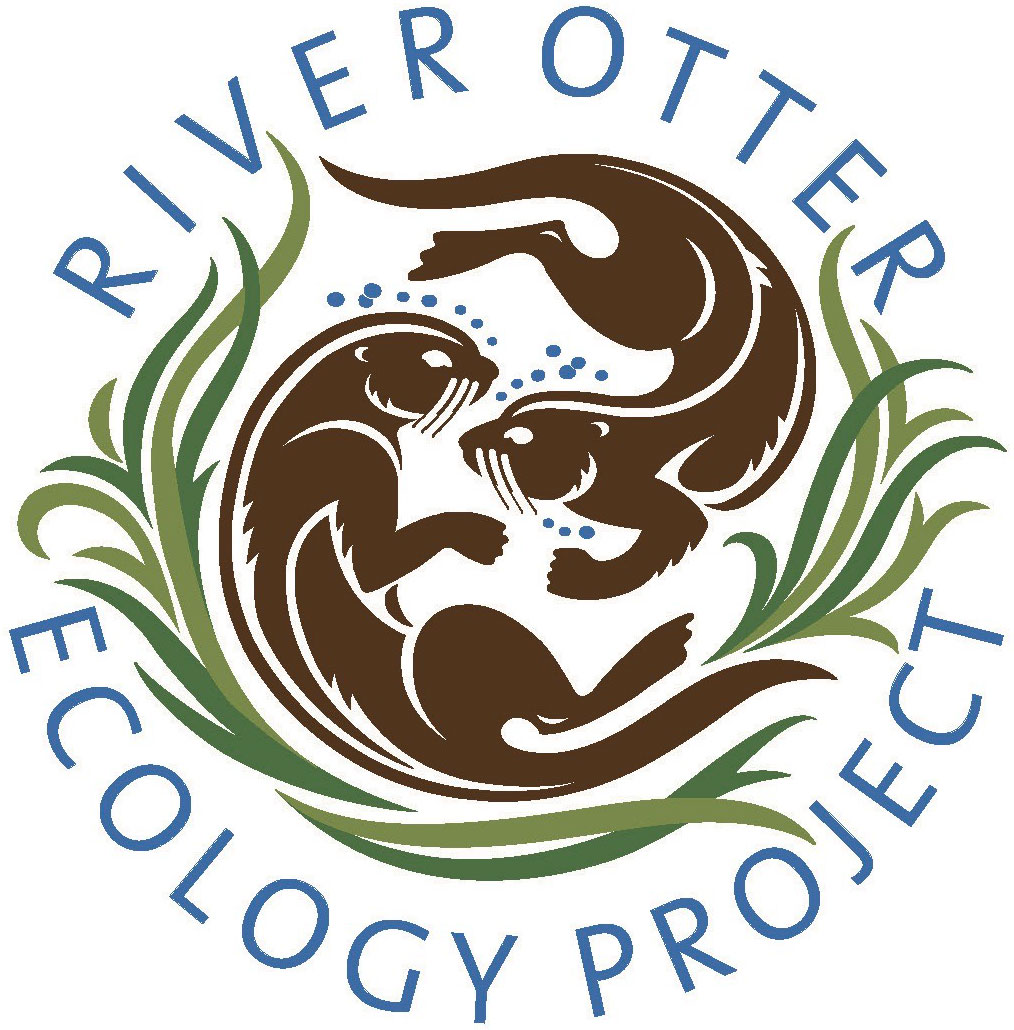by Megan Isadore, Executive Director, River Otter Ecology Project
May 24, 2012
Why is it that I love watching wildlife even more from a kayak than from the ground? Usually, it’s more difficult; the boat rocks and swings around every time I get a bird in my binoculars. The paddle can be problematical. The bird book is always in the dry bag behind my seat, and the “creatures of the bay” book is still at home. So many fascinating creatures are below the water, and difficult to see without taking a swim myself. The kayak is so brightly orange it scares me, let alone the more discreet wildlife minding their own business in the Bay. It’s impossible to sketch in a kayak, (unless you’re Jack Laws, who can most likely draw a perfectly-proportioned flock of mixed birds from a kayak in a tsunami). A lot of volition disappears when you’re on the water.
Paddling out to stalk the elusive Tomales Bay river otters that morning had been an exciting, beautiful, exhausting trial. We missed the ideal time to paddle through the boating channel with the wind and tide helping push us along, and had both against us on the way out to the scout site. We thought to keep in the lee of the point as long as possible, then paddle our heads off across the channel, only working especially hard for the last quarter mile.
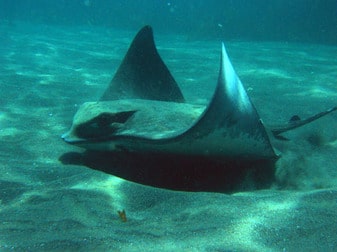
We fly. Some call us cute. Photo: eos.org
But then at the eelgrass beds near Walker Creek, we saw some interesting shapes arising in pairs of rounded-off shark fins, and had to investigate. YES! It was Tomales Bay’s own bat rays (Myliobatis californica), feeding in a herd in the eelgrass beds, maybe 20 or 30 strong. Oh joy! Since the tide was way down, and the bay is quite shallow there, the rays’ “wings” emerged from the water as they raised them, and slipped back under as they propelled themselves through their orchard. The wings are actually pectoral fins, and they look like shark fins because rays are reasonably closely related to sharks. They use those fins for self-propulsion, and also to move the sand underneath them and unearth delicious crustaceans. They crush the crustaceans with their plate-like teeth, and spit out the shells. Picture Weird, hexagonal teeth.
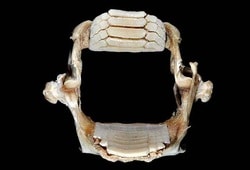
Photo: eol.org
Bat rays give birth to anywhere from 2 to 10 live pups, each one with its own little stinging barb, covered in a sheath and soft at birth. Mama ray says, “Thank you sea goddess!” Those little barbs harden up within a few days to help them defend themselves. I love rays because of the way they glide through the water, their weird flat, rubbery bodies, and their cute faces. Yes I said it. Cute!
In succumbing to the charm of ray wings above the surface, we tarried too long in the eelgrass beds. It’s easy to tarry in the eelgrass beds, even without the bat rays. Coming out of the lee of the point and beginning to cross the channel toward the beach, we got hit by wind and incoming tide at the same time. After I’d struggled mightily for too long to tack across the channel, making little progress, I elected to pull out on a more southerly beach It seemed a good place to seek otter tracks.
Scouting for otters has a lot to recommend it. First, there isn’t a 100% chance of seeing them. I’d say quite a bit less than that unless you know exactly where they are and have been watching them for a while. I proffer that unlikelihood as a gift, because in the search, you find so much else that you might get sidetracked for hours or days. Case in point, the bat rays. Back to the otter scout; I saw a small creek, a trickle, really, running down from a little arroyo. I landed, clambered out and investigated. Lovely, with a wildlife trail leading uphill and perfect for tracks, except that there were many, including scuffs, and none distinguishable for certain as otter tracks.
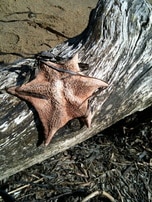
Sea star, high and dry. Photo by Megan Isadore
On the next beach up, the one the husband was presumably landing on at that very moment, I had seen bobcat, coyote and otter tracks before. I always hope for mountain lion tracks on Pierce Point, but haven’t seen any yet. Though, being a novice tracker, I might trip over a mountain lion track and not know it. One lives, watches, listens and learns. Another positive about scouting for anything…..watch, listen, go further, photograph, take notes, go further, take notes, ask questions, learn! You get to indulge your inner 10-year-old. This is good.
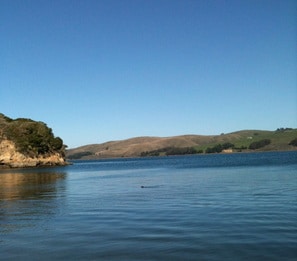
Is that little dot a curious otter? Yep! Photo by Megan Isadore
What is not good is climbing up a wildlife path (picture a damp tunnel lined with poison oak and nettles, as well as other, more salubrious, plants), that’s so overgrown with willow and other shrubs that crawling would be essential. So I simply peered into the dim tunnel and marked the spot on my GPS. Then I began searching the rocks around the beach for otter scat, or spraints. Otters often use prominent rocks as latrine sites.
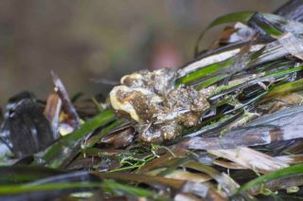
Otter “jelly.” Photo by Paola Bouley
When we find a latrine, we mark the point with our GPS, photograph it and add it to our records. In another post, once the otter research has progressed, I’ll relate more about it. Indeed I did find some otter scat….we spend quite a bit of time ascertaining whether scat is otter or raccoon, as there are otter and raccoon tracks all over the place, both have latrine sites on rocks, and both have similar diets along the bay: lots of crustaceans. Otters leave a distinctive jelly at times, which is a huge help in identifying, as raccoons never leave the jelly. A steady fish diet, which otters often have, means a specific kind of scat, like the dark, oily one on top in the photo below (seen with older, bleached out scat).
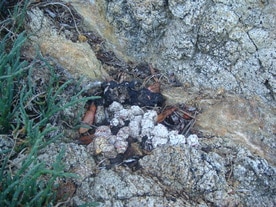
Dark, fresher scat with older bleached scat. Photo by Megan Isadore
No matter what, it’s a learning curve. We photograph, take notes, watch and learn.
Then, the reward….once we’ve had our big paddle, our photos, our notes, our scats and tracks and signs, our struggles to get to where we’re going, our snacks are eaten, we have water left in our bottles and maybe a just a few squares of chocolate left……work done, we head home. That’s the best time of all.
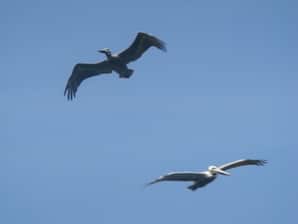
Pellies, suspended. Photo by Megan Isadore
The tide’s coming in, sweeping us southward down the Bay toward Marshall. The wind has quieted down, and when it does blow, it works with the tide. The water level is nice and high, so we don’t have to take long detours around mud flats. That’s when the whole of nature conspires to convince me that I am the luckiest person on earth. No need to paddle much, no rush at all, I lie back in my kayak and let the waves nudge and shove me along. I close my eyes and bask in warm sunlight. I stick my feet out on top of the kayak. I piddle around, not really doing anything. There are five osprey hunting above, a raft of pellies fishing and floating around the oyster racks and landing on one of the wooden rafts. A whole flock of cormorants bobs and dives in concert, chasing a school of fish.
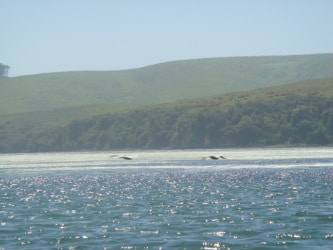
Loitering. Photo by Megan Isadore
Harbor seals and their pups lie fatly on Hog Island, ignoring us. Gulls call, and loons. I watch for the immature bald eagles I’ve heard about out there, but I don’t see them. I don’t try that hard. An osprey flies above my head with a whole fat fish in its claws. I watch it as it moves up and inland, flying eastward and dipping into a copse of trees some way in from the shore. Surely it has chicks, or is bringing food to its mate. It’s a successful bird, and it flies straight and true.
There, suspended between earth and sky, between work and play, between doing and not-doing, there in the ocean where volition has less meaning, I find my place. So much of what we do as humans with our busy minds and busier hands, is relentlessly purposeful. Must we always be so relentless? I leave you with that question.
